Part of a series of articles titled On Their Shoulders: The Radical Stories of Women's Fight for the Vote.
Article
Alice Paul, Woodrow Wilson, and the Battles for Liberty
By Tina Cassidy
President-elect Woodrow Wilson’s train pulled into Washington’s Union Station on March 3, 1913, the day before his inauguration. A relatively thin crowd greeted him and his family before a motorcade took them to a hotel. They drove a roundabout route down an eerily deserted, unadorned Massachusetts Avenue, to H Street and then Fifteenth Street. Few people even noticed them along the way.
“Where are all the people?” Wilson asked as he peered out the car window.
“On the Avenue, watching the suffrage parade.”
President-elect Woodrow Wilson’s train pulled into Washington’s Union Station on March 3, 1913, the day before his inauguration. A relatively thin crowd greeted him and his family before a motorcade took them to a hotel. They drove a roundabout route down an eerily deserted, unadorned Massachusetts Avenue, to H Street and then Fifteenth Street. Few people even noticed them along the way.
“Where are all the people?” Wilson asked as he peered out the car window.
“On the Avenue, watching the suffrage parade.”
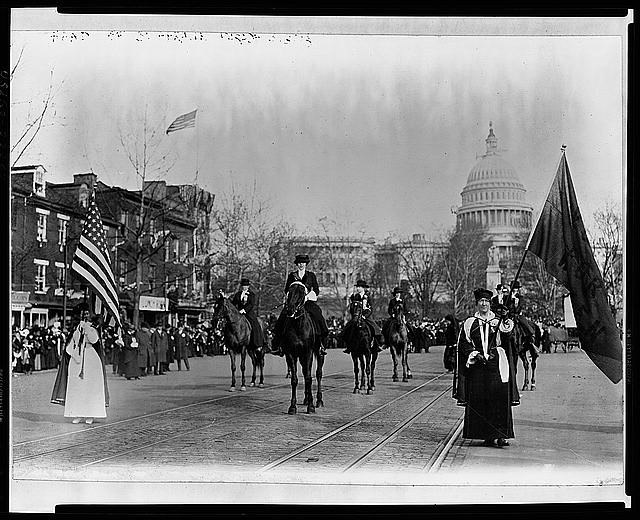
Paul’s idea behind the suffrage procession was to demand a federal amendment granting all American women access to the ballot box. She created floats and banners expressing the ways women contributed to society, as mothers, teachers, nurses, farmers, factory workers, and more. The date Paul chose was no accident: taking over Washington during the inaugural weekend put Wilson on notice that women were rising up in ways never seen before.
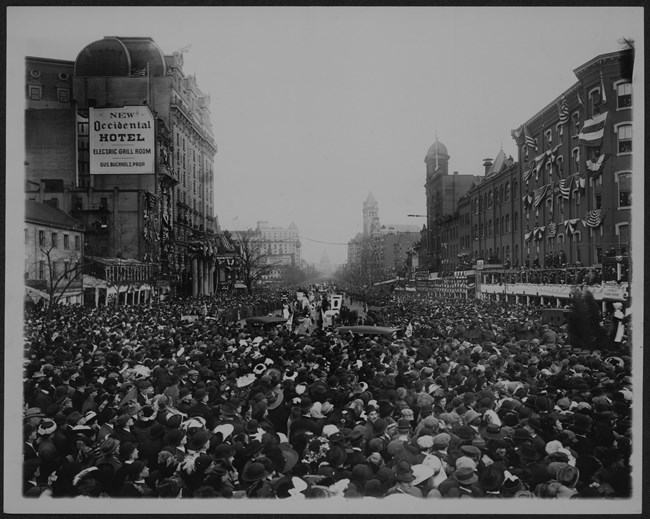
All around Paul men cursed at, shoved, pushed, slapped, hooted and jeered the marchers while the police generally did nothing to stop it. The procession, the largest of its kind in American history, advanced only ten blocks in the first hour before a melee erupted. Although the procession did not go as Paul had planned, the disruptions actually worked in her favor as she and the revitalized suffrage movement were front-page news across America.
It was a day that launched an epic eight-year, David-and-Goliath struggle between Paul and Wilson over the very definition of democracy and American values. Wilson was from a Confederate, slave-owning family and was the first President elected from the South since the Civil War. One of his first acts in office was to racially segregate the Civil Service. Although Wilson considered himself a Progressive Democrat, he was conservative on social issues and a big believer in states’ rights.
What Wilson could not know in those hours before he took the oath of office was that suffrage would be a defining issue of his presidency, and that 18 months later, the assassination of Archduke Ferdinand would suck the world into a vortex of violence. World War I and suffrage would be inextricably linked during Wilson’s administration – both were battles involving liberty and democracy – and the former would push the nation toward the latter.
At first, Wilson thought he could ignore Paul. But she was not easily deterred. During his first month as President, she met with him twice in the Oval Office. Each time, he essentially told her that he had more important things to do, including currency and tariff reform.
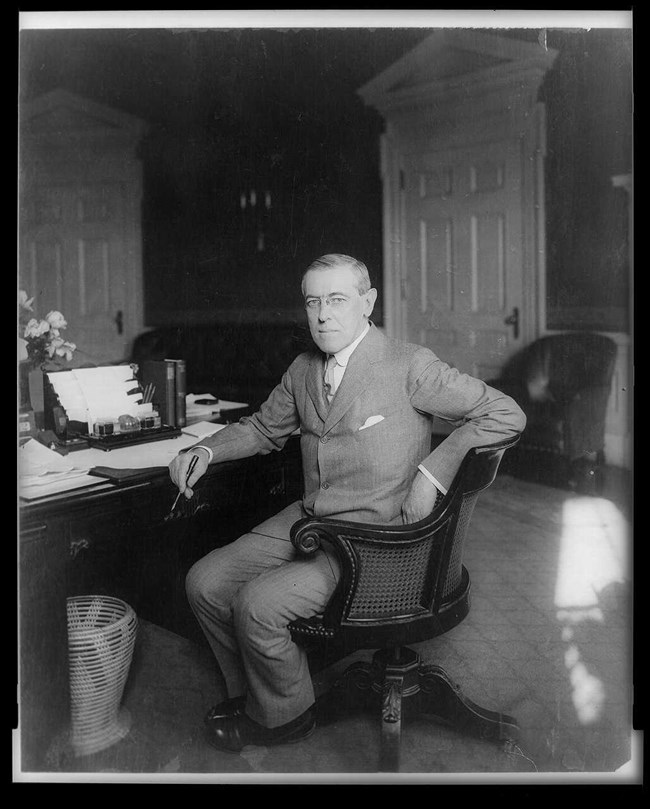
By January of 1917, with Wilson re-elected, Paul had mapped out a broader political strategy that involved a daily picket line of suffragists in front of the White House. Calling themselves The Silent Sentinels, these women took their positions outside 1600 Pennsylvania Avenue. They stood there quietly and held their signs, which begged for answers to tired questions: MR. PRESIDENT, WHAT WILL YOU DO FOR WOMAN SUFFRAGE? HOW LONG MUST WOMEN WAIT FOR LIBERTY?
The sentinels were standing outside for only 40 minutes on the first day of protesting when Wilson returned home from golf in a car that zipped through the gates. The President must have been shocked by what he saw. Never before in the history of America had anything like this ever happened in front of the White House. The range of reactions from passersby was as varied as the people themselves. Some showed respect or admiration, others laughed at the spectacle. And yet the Silent Sentinels persisted, standing at their posts, six days a week, eight hours a day, regardless of the weather and in the face of harassment.
Wilson could not ignore them, even if he tried. The same was true with the war in Europe. Despite his best efforts to broker peace, by April of 1917 Wilson committed to send troops abroad. Most assumed the Silent Sentinels would do their patriotic duty and go home. Some did hang up their sashes; the burdens of war that women would carry went far beyond producing food and knitting sweaters for soldiers, to include working in factories and on the farm, and losing their sons, brothers, and husbands to the fight. The weight of it all engendered sympathy and within weeks, Michigan, Rhode Island, and Nebraska granted women the vote.
Wilson had framed America’s entry into the war around the intangible ideals of liberty. And so, the Silent Sentinels changed the wording on their banners to reflect what they saw as hypocrisy.
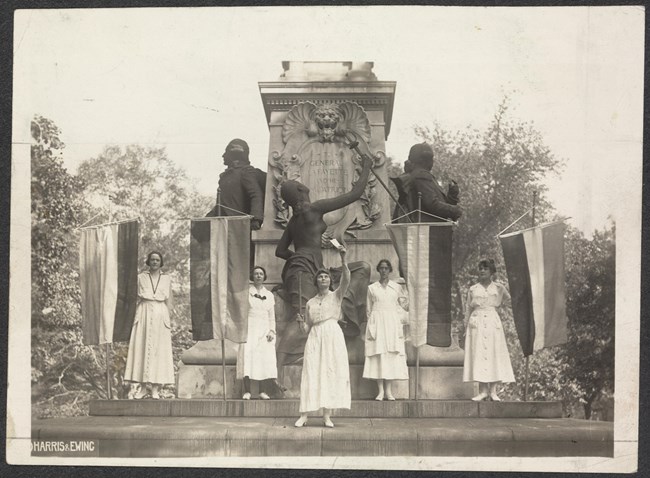
The picketing went on for months. Ultimately, Paul, along with many other women, was arrested and sentenced to prison. They went on hunger strikes to protest the harsh treatment behind bars. Paul was also singled out and locked without merit in a psychiatric ward as foes tried to argue that she was obsessed with Wilson. But the war and the arrests of suffragists only generated more sympathy for a federal amendment, even if the protests turned off a minority of earlier supporters. And Paul and her followers intensified their protests to persuade Wilson and Congress in their favor. As Wilson toured Europe in December of 1918, the suffragists wrote down on slips of paper quotes from the President’s own speeches there, and burned his words in Lafayette Park, in front of the White House, before relocating the protest outside 1600 Pennsylvania Avenue.
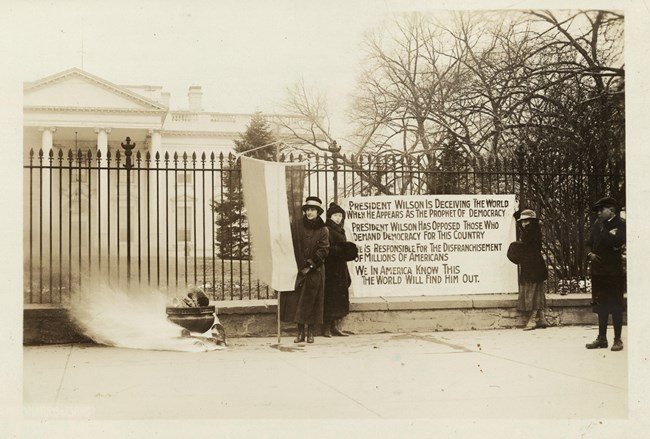
(https://www.loc.gov/resource/mnwp.276030)
For three consecutive days, as the protesters tracked Wilson’s movement across the continent, a pattern emerged. They burned his words, police arrested them, and replacement suffragists lit more fires. Their tactic generated more publicity and support.
Germany surrendered on Nov. 11, 1918, and in many ways Wilson also surrendered to the suffrage cause. Over the course of his presidency, he saw public opinion change in favor of the 19th Amendment, and he realized that to oppose it any longer would damage his political party in the next election. Despite that realization, he refused to acknowledge that his change of heart was due to Paul’s tactics; he continued to ignore (at least publicly) Paul and her disciples while embracing suffragists considered to be more well-behaved and patriotic. In June of 1919, the Treaty of Versailles was signed, officially ending the war. That same month, Congress passed the 19th Amendment, sending the legislation to the states for ratification, which was finally completed in August of 1920. The suffragists likely viewed the passage of the 19th Amendment the way General Pershing viewed the end of the bloody Battle of the Argonne Forest: grateful for the win, and bitter there had to be a fight at all.
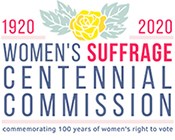
Author Biography
Tina Cassidy writes about women and culture. In addition to Mr. President, How Long Must We Wait? Alice Paul, Woodrow Wilson and the Fight for the Right to Vote, she is the author of Birth: The Surprising History of How We Are Born; and Jackie After O: One Remarkable Year When Jacqueline Kennedy Onassis Defied Expectations and Rediscovered Her Dreams. A former journalist who spent most of her career at the Boston Globe covering business, fashion and politics, she is the Chief Marketing Officer of WGBH. Cassidy serves on the board of The Conversation U.S. She lives in the Boston area with her husband, the author Anthony Flint. They have three sons and a Norfolk Terrier named Dusty.
Bibliography
Haynes Irwin, Inez. The Story of Alice Paul and the National Woman’s Party. Fairfax, VA: Denlinger Publishers Ltd, 1977.
Stevens, Doris. Ed. Carol O’Hare, Jailed for Freedom: American Women Win the Vote, Troutdale, OR: NewSage P, 1995.
Harris & Ewing (Photographer). “Party watchfires burn outside White House, Jan. 1919.” Photo. Library of Congress, accessed March 26, 2020.
Harris & Ewing (Photographer). “Suffrage protestors burn speech by President Wilson at Lafayette Statue in Washington, D.C.” Photo. Library of Congress, accessed March 26, 2020
“Head of suffrage parade in Washington, D.C., Mar. 3, 1913.” Photo. Library of Congress, Bain Collection, accessed March 26, 2020.
“National Woman's Party Protests During World War I,” National Park Service, last updated May 15, 2019.
“‘Picket’ the White House,” Washington Post, Jan. 10, 1917.
“President Woodrow Wilson, full-length portrait, seated at desk.” Photo. Library of Congress, accessed March 26, 2020.
Walton, Mary. “A Woman’s War.” American Experience, PBS website, accessed March 26, 2020.
“Wilson Evades Vast Crowd,” New York Times, March 4, 1913.
Tina Cassidy writes about women and culture. In addition to Mr. President, How Long Must We Wait? Alice Paul, Woodrow Wilson and the Fight for the Right to Vote, she is the author of Birth: The Surprising History of How We Are Born; and Jackie After O: One Remarkable Year When Jacqueline Kennedy Onassis Defied Expectations and Rediscovered Her Dreams. A former journalist who spent most of her career at the Boston Globe covering business, fashion and politics, she is the Chief Marketing Officer of WGBH. Cassidy serves on the board of The Conversation U.S. She lives in the Boston area with her husband, the author Anthony Flint. They have three sons and a Norfolk Terrier named Dusty.
Bibliography
Haynes Irwin, Inez. The Story of Alice Paul and the National Woman’s Party. Fairfax, VA: Denlinger Publishers Ltd, 1977.
Stevens, Doris. Ed. Carol O’Hare, Jailed for Freedom: American Women Win the Vote, Troutdale, OR: NewSage P, 1995.
Harris & Ewing (Photographer). “Party watchfires burn outside White House, Jan. 1919.” Photo. Library of Congress, accessed March 26, 2020.
Harris & Ewing (Photographer). “Suffrage protestors burn speech by President Wilson at Lafayette Statue in Washington, D.C.” Photo. Library of Congress, accessed March 26, 2020
“Head of suffrage parade in Washington, D.C., Mar. 3, 1913.” Photo. Library of Congress, Bain Collection, accessed March 26, 2020.
“National Woman's Party Protests During World War I,” National Park Service, last updated May 15, 2019.
“‘Picket’ the White House,” Washington Post, Jan. 10, 1917.
“President Woodrow Wilson, full-length portrait, seated at desk.” Photo. Library of Congress, accessed March 26, 2020.
Walton, Mary. “A Woman’s War.” American Experience, PBS website, accessed March 26, 2020.
“Wilson Evades Vast Crowd,” New York Times, March 4, 1913.
Last updated: December 14, 2020
